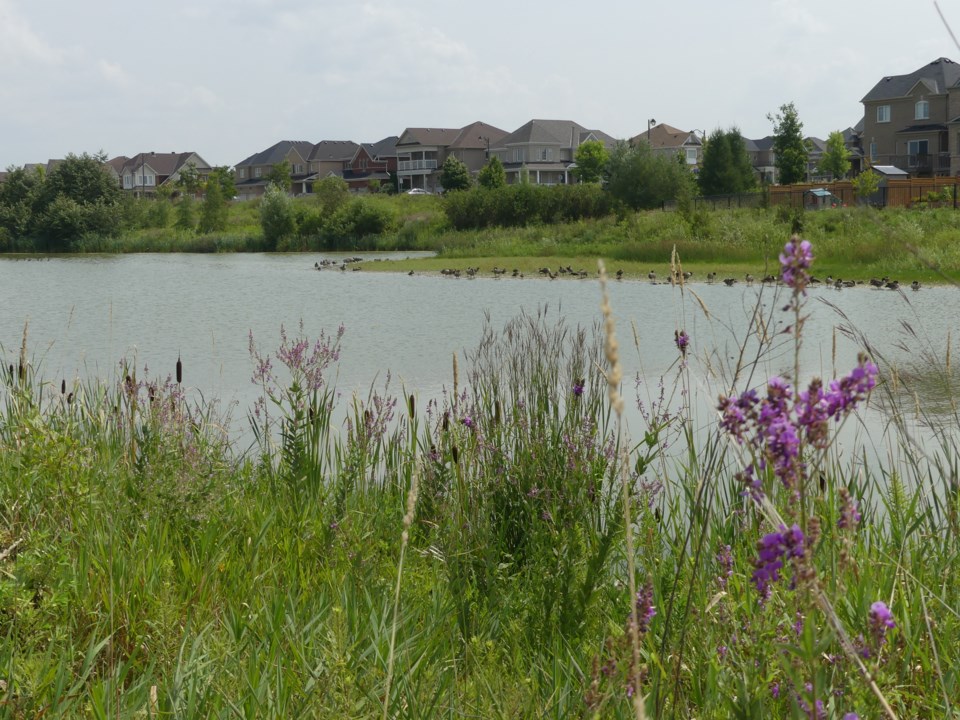Look along the edge of a stormwater pond, in an undisclosed location. There is a glimmer of gold among the weeds and roots.
A school of carassius auratus: common goldfish.
Goldfish are not native to Ontario. They are ‘pets’ released to the wild by owners who think it’s the nice thing to do, rather than return the fish to a pet store, give them away, or even dispose of Goldie the goldfish.
Unfortunately, goldfish are members of the carp family, native to east Asia, and they are invasive.
Released into the wild, they can grow up to 40 centimetres in length.
In fact, there is a commercial fishery for “golden carp” in Lake Erie.
There are also concerns that, as bottom feeders and big producers of waste, they can have a big impact on water quality.
Just ask David Lembcke, manager of environmental science and monitoring with the Lake Simcoe Region Conservation Authority (LSRCA). He discovered the goldfish problem while looking into the effectiveness of existing stormwater ponds in managing pollutants.
Stormwater ponds are not natural features. They are specifically constructed to provide flood control and to trap pollutants and nutrients – from heavy metals and pesticides to phosphorus – that could negatively affect downstream watercourses.
“They’re doing some things well, others not well,” Lembcke said, noting that, over the past few years, “we’ve had really strange instances of some ponds that were not clearing up.”
Particles and pollutants are supposed to settle out in stormwater ponds, allowing the water to clear before it leaves the facility.
But in the puzzling ponds, the turbidity (cloudiness in the water) remained high.
“We just couldn’t figure out why,” said Lembcke.
The LSRCA looked at the size of the pond, the nature of the catchment area and whether there were algal or diatom blooms.
“Nothing was adding up.”
Until one day someone observed a school of goldfish in one of the ponds, “and the light bulb went off.”
As bottom feeders, goldfish keep the sediments stirred up, preventing them from settling out.
That was something Lembcke and his team understood well, but they questioned whether there could possibly be enough goldfish to have an impact, and wondered how the fish could survive in what was essentially a pollution-control facility, with high salinity, low oxygen levels and high levels of pollutants.
They found that there are “very, very large populations of these fish,” he said, even though the turbidity makes it difficult to estimate exact numbers.
Not only are goldfish surviving the harsh conditions; they are thriving and reproducing.
“Some of these ponds have thousands of goldfish,” he said.
The finding poses several problems. Goldfish are invasive and although the ponds seem to be containing the populations, “we certainly don’t want them to get out into the receiving water bodies.”
Then there’s the turbidity issue. Not only are the solids and pollutants not settling out in the “goldfish ponds,” but there is the threat that the materials will be washed into downstream water bodies, “definitely short-circuiting the function of the ponds," Lembcke said.
For the past two years, he and his team have been studying the ponds and have found a widespread co-relation between murky water and goldfish.
“We’ve sort of identified that turbid ponds are related to goldfish,” he said. “It’s really difficult to go out there and confirm how common this is.”
The problem seems to be more common in residential ponds than in industrial or commercial areas.
“In one pond, we even found a huge koi,” he said, which supports the idea that people are releasing pet fish into the wild, despite signs that warn people not to dump aquarium species.
It seems to be an issue right across Ontario.
“We’ve been chatting with a number of municipalities. Now light bulbs are going off,” Lembcke said.
Bradford West Gwillimbury is one of those municipalities.
“We can suspect that our stormwater ponds have goldfish in them,” noted Terry Foran, director of community services. “We performed a capital program last year to clean one of the storm ponds as a maintenance activity, and we did find goldfish in that pond, along with other native species typical to our geographic area.”
As for the impact of the fish, the town is waiting for the LSRCA’s report.
“Once the LSRCA has concluded their study and made possible recommendations on how to better control the impacts, we will consider those and hopefully implement them at a local level," Foran said.
What is next?
“That’s a great question,” said Lembcke. “These fish, once they’re in there, are very, very tough to get rid of… Once they are out there, your strategies very quickly have to change.”
In one conservation authority jurisdiction, it took three years of electrofishing to rid a stormwater pond of goldfish.
Right now, the idea is to try to clear out the goldfish when the affected ponds come up for maintenance, while taking steps to ensure the invasive fish aren’t flushed into the receiving water bodies.
“It’s very challenging,” Lembcke said. “They’re tough… We have to throw something pretty tough at them to get rid of them.”
Goldfish aren’t the only problem in some stormwater ponds. The amount of garbage either thrown or blown into the ponds is “shocking,” Lembcke said.
“We keep getting surprised.”
As for goldfish: “We’re used to dealing with the chemical side. It’s been a bit of a curve ball for us.”



